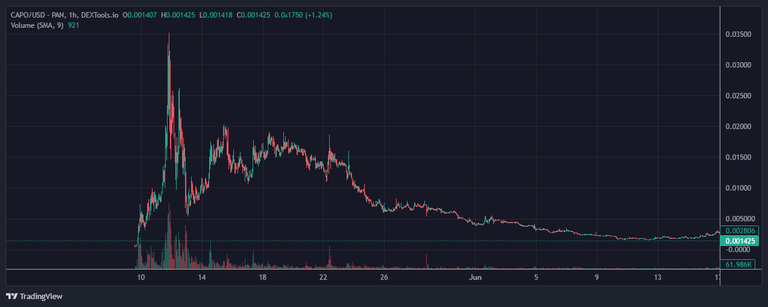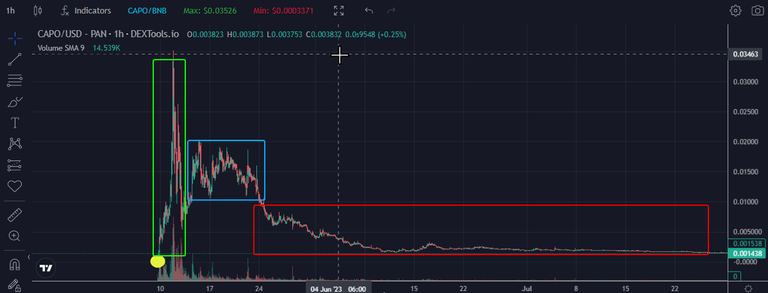Greetings everyone! Today I want to discuss a bit about tokens like SHARD and PART.
Could the fall of these tokens have been avoided in some way?
These are gaming tokens from the Golem project.
Firstly, it's worth mentioning the fact that from the very beginning, "Golem administrators" didn't block multi-accounts. This allowed some clever individuals to extract profits from the project.
When profits are urgently extracted from a project, typically their tokens are sold. This pulls the project down. While the player dynamics were positive and the number of players increased by 300-400 people every day, the price was sustained by new players who wanted not only to buy a character but also to level it up.
Once these players run out and the game lacks development (in terms of new markets, for example, the BNB or ETH network) - incoming players dry up, and those who are already in the project start SELLING the token. The players buying the token almost disappear since most have already purchased it. There's no influx of new players. Consequently, the combination of sellers and multi-accounts start pressuring the price downwards.
As a result, the token heads to the bottom. Or close to it.
I can notify you that the majority (99%) of projects are created for the sake of pumping.
If you look at the model over several days, it might look something like this.
This is a typical pump and dump token, created to benefit from its growth. And then it's forgotten.

Tokens have certain life cycles, and these cycles often resemble each other. This cycle can last for a very long time - a couple of years, quickly - a couple of months, super quickly - a couple of weeks, lightning-fast - two to three days. However, for some scam coins, the cycle can last for several hours or even a few minutes.
The cycle is as follows:
- Creation (yellow dot)
- Price pumping (green line)
- Coin unloading (blue)
- Dump and forgetting the token (red - end of cycle)
Here's how it looks on the same graph:

As seen from the second graph, for any project (even if it has a good backstory), there is a cycle that can be characterized as growth! Yes, every growth can have different potential. For instance, if a coin suddenly gets listed on Binance out of the blue. This provides additional potential and a period during which the coin will skyrocket to space before falling down.
The entire mechanics have been worked out long ago and operate like Swiss watches! The whole idea behind such projects is to gain short-term profit and forget about it. After that, move on to the next project.
Of course, within most projects, the main task is to find such a project in its very early stages or close to it - the creation phase. Because if you enter a project too late, you will lose money, time, and nerves!
However, one crucial aspect still remains. If you didn't manage to enter the project right from the start, but you know how to trade, you can still profit from the market. You just need to understand and correctly navigate market levels.
In most cases, though, the situation will end up the same way - with a loss of money.
I'm confident that Golem won't be the last project in the Hive ecosystem. There will be other projects. There will be better projects, and undoubtedly worse ones too.
When attempting to enter a specific project, it's essential to understand at what stage you're entering and what to expect from price behavior. But let's get back to our Golems...
In the case of Golems, there was another nuance - the geometric growth of certain individual players who entered the project at the very beginning and played the game successfully (successfully meaning they invested a little money into development and quickly started growing). There was a group of about 20 people who were earning tens of thousands of coins per day. And naturally, when they received this income, they immediately sold all their PART and SHARD for HIVE. Alongside them, those who decided to act through multi-accounts also sold.
And regular players acted in the same way.
In the crypto space, there are individuals who, before continuing to play, execute a "return on investment" (that's me). I put $15 into the game and withdrew $150.
I'm still playing, but the belief that the project will revive diminishes with each passing day.
The reason my faith in the project diminishes is described above in the Pump and Dump cycle.
Can it happen that the ecosystem changes? Yes, that's a quite possible scenario.
Can the ecosystem of a project change, and token emissions that were positive become negative? Yes, that's also possible.
Could this happen tomorrow? Yes. And could it happen in a year? Yes, of course!
But could it also never happen? That's also very possible!
What overall conclusion can be drawn about projects? The conclusion is quite simple - don't fall in love with projects. Even Tesla has periods when its stocks plummet significantly.
But Tesla is a large corporation with thousands of people on board! They produce a product.
Games don't produce anything. Their concept is clear - motivating people to play. But often, people come to such games to quickly make money and leave. This very advantage (money) becomes the biggest disadvantage (when there's no money, people forget about the project).
That's why it's always important to carefully choose the investments you want to enter.
Someone might think and argue: Well, okay, let's suppose all these projects have the same ending, so how do I understand which stage I'm entering?
Yes, it's very easy. All you need to do in this case is to learn to look at the 1 Day, 1 Week, and 1 Month charts. By switching between these intervals, you will undoubtedly and accurately determine the current stage of the project.
For instance, if we are talking about projects that sell their tokens through an Initial DEX Offering (IDO), the scheme is slightly different because entering a trade at an early stage is considered a purchase when the token isn't yet on exchanges. Selling is often seen as unloading the token.
And in this moment, to understand if there's a chance for the token to go even higher, it depends only on:
- How good the project is itself (according to statements from developers and the community).
- How good its PR and marketing are (as this also has a strong impact).
- How many planned listings there are (not only on Binance but on various exchanges).
Epilogue
In any case, I've ended up with a quite lengthy dialogue already. I just wanted to demonstrate the life cycle of the majority of projects in the crypto industry. If you independently analyze dozens, hundreds, and even thousands of projects, it becomes clear that most of them are empty shells. Whether this is good or bad is hard to say. No one wants to work for the greater good; however, everyone wants to quickly make a profit. And after obtaining this profit, people want to leave. Either retire or exit the project to create a new one.
I follow many projects that didn't deserve to exist (like EOS), but they were created by the twist of fate and not without the help of trusting users who were waiting for ToTheMoon. EOS, for example, also completed its cycle and deflated. Moreover, unlike other blockchains, it turned out to be one of the worst!
Imagine a blockchain (oh, the horror!) where you can't make a single transaction if you don't have the resources, which you need to buy or rent. With EOS, for instance, as a person with many wallets, I couldn't even register a wallet for about a week. And people poured a billion dollars into this project. A BILLION! Was this project worth that money? No, I believe it wasn't.
Can such projects repeat in the future? Very likely, yes!
What awaits such projects in the end? The same fate as shown in the first graph - fading into oblivion.
Let's end the discussion for today. Thank you for your patience if anyone read through to the very end! Have a good mood and don't lose your money! =)
Posted Using LeoFinance Alpha